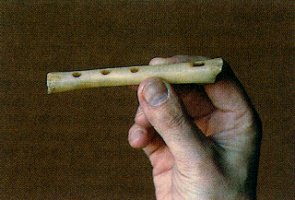| In 1990 a pipe made of the bones of a bird was found in Germany. This pipe had a length of 12.6 cm and there were three holes made in it. The pipe appeared to be 35.000 years old and was used to provide music. Therefore this pipe is also known as “the oldest flute”, though this flute doesn’t yet resemble a recorder the way we know it these days. Only thousands of years later the first flutes with a plug were made.
The oldest recorder was built the second half of the fourteenth century. This recorder was found in 2005 in Tartu, Estonia. The instrument was made of maple-wood, with a plug of birch-wood and it had seven fingerholes. These holes were made in a straight line, so the player could decide for himself if he would use his left- or righthand as upper hand.
At the beginning of the sixteenth century, the instrumental music began to evolve. The first educational musicbooks appeared, in which was described how a recorder should be used. And recorders which were made had a reach of alsmost two octaves. These recorders have an inner-bore which is more or less cylindrical. There are however only large recorders of this period of time left, because all the smaller ones have perished.
During the seventeenth century the recorder became more and more popular. Recorders are made in different countries in Europeand a lot is written about it. The growing popularity of the recorder becomes when the Bassano brothers play this instrument on Queen Elisabeth’s funeral. At that time the size of a recorder varies from a small one, called “Klein Fl`ttlin” in G’ till a large one, called “Gro8bass”, which is played in F’. These recorders still have two fingerholes at the bottom, so both the left and the right hand can be used as the lower hand and they are all made of one piece.
In the second half of the seventeenth century, the first recorders made out of two or three pieces appeared, when the family Hotteterre received an assignment to re-decorade the recorder. As a result of it, the sound became warmer and softer. This sound is typical for the baroque recorder. At this time the first builders started using harder kinds of wood, like ebony and grenadilla. In the former centuries, only the softer kinds of wood were used to make a recorder, since those are a lot easier to work on.
The first half of the eightteenth century is also known as the flourishing period of the recorder. In this time the soprano and the alto were first used as a solo-instrument. The tenor and bass were a lot less popular. The first recorders made of european boxwood appeared, which were often decorated with ivory rings. For very wealthy players, recorders were also made entirly out of ivory. The builders of windinstruments were in this period of time especially active in The Netherlands, England and Germany. Famous builders were for instance Steenbergen, Terton, Denner, Stanesby and Bressan. The recorders made by them are characterised by a lot of decorations of ivory, gold and silver.
In the course of the eightteenth century, the symphony-orchestra’s became more popular. In these orchestra’s there was no place for the recorder. Because of that, the recorder almost disappears. Only instruments a bit like the recorder are made, such as a Flageoletor a Csakan.
When in the end of the nineteenth century people become more interested in the past, the recorder attracts a little more attention. This continues during the twentieth century. Especially the family Dolmetsch played an important role with this re-discovery of the instrument. They were also the ones who invented the double boring.
After the war the recorder developed as an instrument for beginners. Music teachers teach the children very often how to play a recorder, before they can play another instrument. Besides that, the recorder is still used as a solo-instrument. There are several music-groups who play different kinds of music on their recorders.
|

Replica of a recorder, made from shin boneof a sheep. The original instrument from the early part of the 13th century, was found during excavations in Århus, Denmark, but this type of recorder is also known from other excavations from earlier periods.
|









 Recorder specialist |
Recorder specialist |